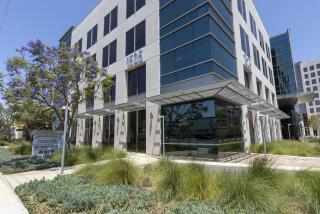They Give Disabled Users a Ring for Their Money
- Share via
When Alexander Graham Bell invented the telephone back in 1876, he didn’t quite accomplish what he had set out to do, says Brenda Premo, executive director of the Dayle McIntosh Center for the Disabled in Anaheim.
“His mother was hearing-impaired,” Premo says, “and he was trying to invent a device that would help her.”
Ironically, for most of its history, “the telephone hasn’t been accessible to the very people it was developed for,” she says.
But now, thanks to Dialog, a project in Orange and Riverside counties designed to link disabled people with specialized telephone equipment, Bell’s original goal may be reached at last.
And just in time too, says Premo, a presidential appointee to the National Council on Disability, who is legally blind: “The telephone and the television are becoming two of the main portals through which we can receive our information about the world.”
Premo herself depends heavily on the telephone, not only for voice conversations but also for linking via computer to various on-line networks and other computers. She uses a Macintosh computer adapted with a voice synthesizer that speaks words as they appear on the screen. The computer also can enlarge text.
For the last five years, California telephone companies have been required under the Telecommunications Devices for the Disabled Act to provide free specialized or supplementary equipment to customers with speech, hearing, vision, motion or other impairments that interfere with their ability to use a phone.
But many who could benefit from such services aren’t aware of them, so the Dialog program was developed with a $45,000 grant from the California Public Utilities Commission’s Telecommunications Education Trust to increase public awareness.
That campaign includes a presentation at 7 p.m. tonight at the Heritage Park Youth Services Center at 4601 Walnut Ave. in Irvine. Speakers will explain and demonstrate more than a dozen services and devices.
Deaf callers, for example, can use a telecommunications device for the deaf (TDD) to “talk” on the phone by typing on a keyboard. The free California Relay Service, established in 1987, is available 24 hours a day, 7 days a week.
Relay operators help TDD users have conversations with non-TDD users, with relaying voice to keyboard and vice versa. Callers with TDDs can call (800) 342-5966, and those without TDDS can call (800) 342-5833. A surcharge on all telephone customers’ monthly bills pays for the service.
For those who are not deaf but whose hearing is impaired, devices are available to increase the volume of a ringing telephone and amplify the receiver’s sound.
Those unable to hold a telephone receiver may qualify for free speaker phones or headsets. For severe speech impairments, TDDs or other devices, such as speech amplifier handsets or artificial larynxes, are available at no charge.
Braille TDDs are available for those who are both blind and deaf, as well as wrist alerts that vibrate to signal an incoming call.
Disabled, low-income customers may qualify for the universal lifeline telephone service, which provides basic telephone service for half the regular rate.
Free touch-tone and speed calling, free directory or operator aid, the talking yellow pages, the teleconsumer hot line and other services are also available.
“Just being able to get that dial tone can give you access to so much,” Premo says. “It opens the door. If you can use a telephone, you’re much more likely to be able to live independently. You can link that to a computer and possibly even work from home. There’s so much people could do if they just knew what was available.”
Premo says there are devices to help with just about every disability: “There are phones that can be started with a puff of air or a whistle. There are photo phones, with pictures instead of numbers for speed dialing, to help the developmentally disabled or those with brain injuries who can’t remember numbers.
“We’re trying now to come up with something that will help people with severe cerebral palsy and have spasticity and no voice. They can’t type on a TDD, but they can’t talk, either.”
She is confident that eventually the telephone can be adapted for everyone who needs to use it.
Premo says both Pacific Bell and General Telephone have been very cooperative in helping disabled customers find equipment that will help them. Debbie Chang at the center also provides referrals for disabled callers. And members of Telephone Pioneers, a group of long-term and retired telephone company employees, also offer volunteer services.
The Dialog program also helps disabled customers understand the codes and other information on their phone bills.
To serve disabled Latino customers who speak no English, Dialog brochures are being translated into Spanish, Premo says.
“We’re also trying to find a Vietnamese word-processing or translation program,” she says.
Tonight’s presentation will be in a wheelchair-accessible room and will be signed for the deaf. For information, call 772-8285 (voice) or 772-8366 (TDD).
More to Read
Sign up for Essential California
The most important California stories and recommendations in your inbox every morning.
You may occasionally receive promotional content from the Los Angeles Times.













